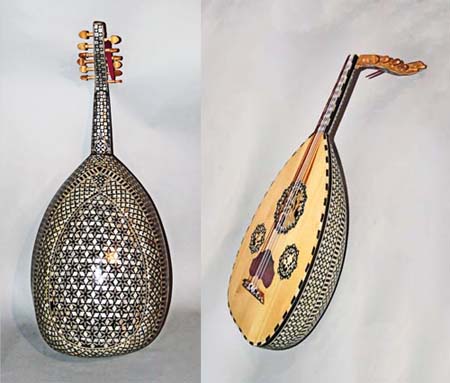
Owner: HWMC
Catalog#: 2AF-CHLT-16
Lutes
Egypt (Arabic) Oud
Egypt
Egyptian
Wood, metal strings, mother-of-pearl, bone
Length: 34 in; Width: 15 in
Late 20th century
Chordophone – Lute
The ud (oud) is a short-necked plucked lute from the Arabic world, used in North Africa, Palestine, Lebanon, Jordan, Syria, Iraq, the Arabian Peninsula, and Iran. (The Arabic spelling for this instrument is ud) It is also believed to be the ancestor of the European lute. The classical ud (oud) of the Arabs, consists of a large pear-shaped soundbox formed from 16-21 ribs (strips) of wood glued together with a soundboard made of soft wood that has one or (most often) three rosettes. Models include a five-course (10 strings); six-course (12 strings, or 5 pairs and 1 low string), and seven-course (6 pairs and 1 low string). The fretless fingerboard is flush with the sound board and the pegs are inserted from both sides of an open pegbox, which is bent at an angle backwards at the top end of the fingerboard. Depending on the regional characteristics of the ud (oud), the tuning, number of strings, size, and shape differs from each other.
This Egyptian oud is very decorated with inserted wooden rosettes, surrounded by inlay of mother-of-pearl and black-and-white colored wood. The entire back is also finished with mother-of pearl inlay. It has 5 pairs of strings plus a single drone string and is played with a long (thin) plectrum. A possible tuning for this oud is D GG AA dd gg c’c’.
